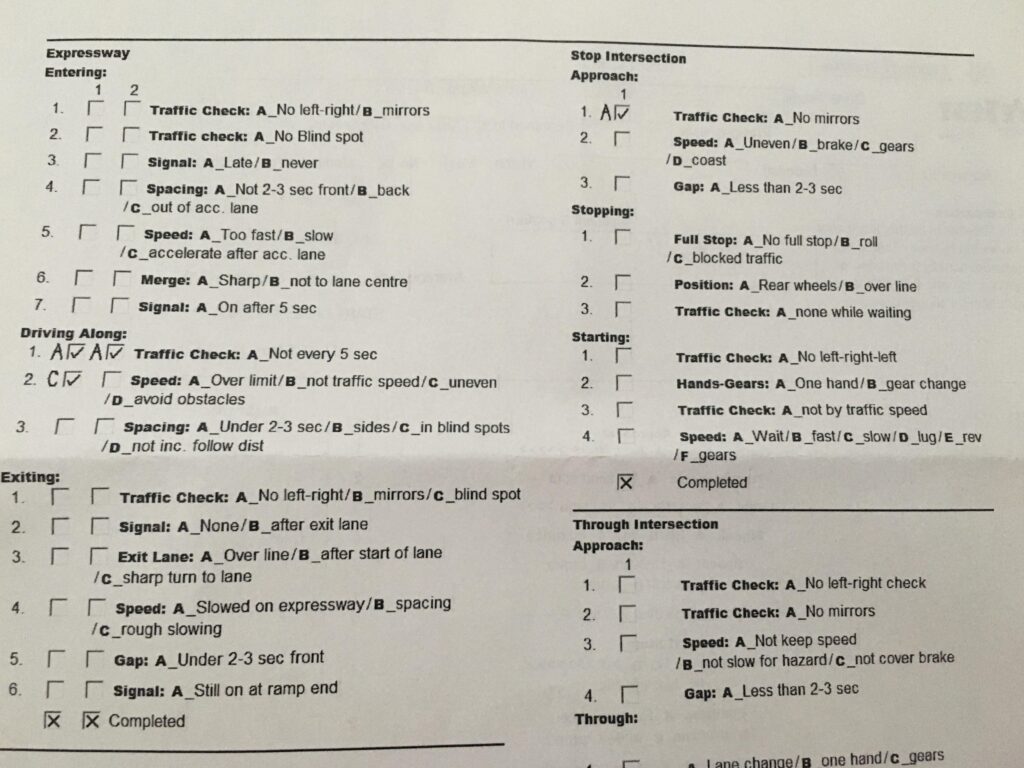the G Road Test Examiner Sheet in Ontario, If you’re preparing to take the G road test in Ontario, understanding the examiner’s evaluation criteria is crucial for success. The examiner uses a detailed checklist, known as the examiner sheet, to assess your driving skills and behaviors during the test. In this blog post, we’ll break down what you need to know about the G road test examiner sheet and how you can prepare effectively.
What is the G Road Test Examiner Sheet?
The examiner sheet is a standardized checklist used by Ontario’s Ministry of Transportation to evaluate G road test candidates. It covers various aspects of driving performance and safety, ensuring that drivers meet the provincial standards before receiving their full G license. While specific details of the sheet are not publicly available, general categories typically include:
- Pre-Drive Check: Verifying that the candidate knows how to perform basic vehicle safety checks, such as adjusting mirrors, using signals, and checking lights.
- Driving Skills: Evaluating the candidate’s ability to perform essential driving maneuvers safely and effectively, including:
- City Driving: Navigating intersections, traffic lights, pedestrian crossings, and residential streets.
- Highway Driving: Merging onto highways, changing lanes, maintaining speed limits, and exiting highways safely.
- Defensive Driving: Observing and reacting to potential hazards, using mirrors and signals appropriately, maintaining proper following distances, and yielding the right-of-way.
- Vehicle Control: Assessing how well the candidate manages vehicle controls, such as steering, braking, acceleration, and gear shifting (if applicable).
- Observation and Communication: Checking if the candidate demonstrates good observation skills (checking blind spots, mirrors) and communicates effectively with other road users (using signals, making eye contact).
How to Prepare for the G Road Test Examiner Sheet
1. Study the Ontario Driver’s Handbook
The Ontario Driver’s Handbook is a comprehensive guide to road rules and safe driving practices. Reviewing this manual will reinforce your knowledge of traffic laws and help you understand what the examiner expects from you during the test.
2. Practice Consistently
Practice driving in various conditions, including city streets, highways, and residential areas. Focus on mastering essential maneuvers such as lane changes, turns, and parking. Consider taking lessons from a qualified driving instructor to refine your skills and receive constructive feedback.
3. Understand the Test Route
Familiarize yourself with common test routes in your area. While the specific route may vary, being comfortable with the general road conditions and traffic patterns can boost your confidence during the test.
4. Conduct a Pre-Drive Vehicle Check
Before your test, ensure your vehicle is in optimal condition. Check all lights, signals, brakes, tires, and fluid levels. Being prepared demonstrates your commitment to safety and readiness for the road test.
5. Stay Calm and Focused
Nervousness can impact your performance during the test. Practice relaxation techniques such as deep breathing or visualization to stay calm. Focus on driving defensively, following all traffic laws, and communicating effectively with the examiner.
6. Review Common Mistakes
Be aware of common errors that may lead to deductions or test failure, such as failing to check blind spots, improper signaling, rolling stops, or exceeding speed limits. Practicing these skills consistently will help you avoid these pitfalls.
What to Expect After the Test
After completing the G road test, the examiner will provide feedback on your performance. If you pass, congratulations! If not, take the feedback constructively and use it to improve your skills for future attempts.
Conclusion
Understanding the G road test examiner sheet is essential for preparing effectively and confidently. By familiarizing yourself with the evaluation criteria, practicing consistently, and maintaining a calm demeanor during the test, you can significantly increase your chances of passing the G road test in Ontario. Remember, preparation and a commitment to safe driving are key to earning your full G license. Good luck on your journey toward becoming a licensed driver!
g road test examiner sheet ontario, g road test examiner sheet ontario 2024, ontario g test checklist 2024, g2 road test examiner sheet ontario, g road test checklist, g road test examiner sheet ontario pdf, alberta road test checklist, tdg test answers pdf, g2 road test checklist pdf, alberta class 5 road test checklist, g test examiner sheet, g test ontario checklist, road test sheet, road test score sheet ontario, ontario g road test checklist, how to become a driving test examiner in ontario, g2 road test marking sheet, driving test sheet, g road test marking sheet, g test checklist, ontario g2 road test score sheet, g2 test sheet, g drive test checklist, g driving test checklist, ontario g test checklist, ontario drive test score sheet, g2 road test score sheet, alberta road test score sheet, alberta road test marking sheet, g2 examiner sheet, driving test pdf ontario, g2 road test checklist 2024, seniors driving test questions ontario, g2 road test examiner sheet ontario pdf, ontario g test marking sheet, ontario g driving test marking sheet, g test marking scheme, ontario g test score sheet, g2 test marking sheet, ontario g driving test checklist, g license test, alberta road test sheet, alberta class 5 road test score sheet, g test marking sheet, class 5 alberta road test score sheet, g2 road test sheet, alberta drivers test checklist, drivers license test sheet, nova scotia road test checklist, alberta driving test checklist.
you might also like these:
